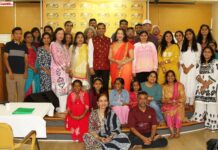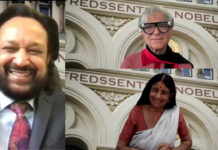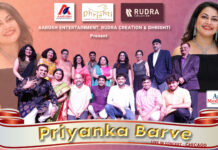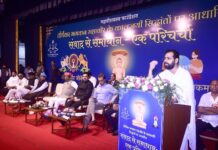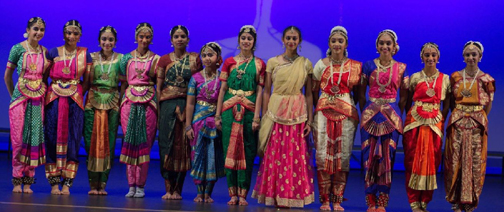
ST LOUIS, MO: The first ever Indian dance drama festival conceptualized by Indian dance Guru Kalayogi Prasanna Kasthuri for several years came to reality on April 28-30 in St. Louis and the St. Louis’s art-lovers, patrons, businesses and art agencies pitched in to make this a great success.
The huge importance of this unique event was formally acknowledged with the St. Louis city proclaiming April 29 as the “Day of Indian Dance Dramas” and made it a permanent document in its annals. More than 160 dancers participated in this three day dance festival attended by more than 1100 people. The Lifetime Achievement Award was given to senior dance Gurus Rathna Kumar (Houston) and Sudha Chandrashekar (Michigan). The award included a plaque, a shawl and $1000 cash prize.
The three day festival featured 12 full length dance productions from dance companies across the USA – New Jersey, Chicago, Indianapolis, San Antonio, Baltimore, Washington DC, Detroit, San Francisco, Pittsburgh, Houston, Dallas, and St. Louis.
The festival also played host to Natya idol dance competition with 46 participants in various Indian classical dance styles of Bharathanatyam, Kathak, Kuchipudi and Odissi coming from across the country.
The dance festival began with Subhadra Parinaya choreographed by Prasanna Kasthuri from St. Louis in Bharathanatyam style. The home team Soorya Dance Company inaugurated the festival with this story of Pandava prince Arjuna falling in love with Krishna and Balarama’s sister Subhadra against the wishes of Balarama and Arjuna finally marrying the princess. Guru Prasanna Kasthuri presented an eloquent abhinaya as a Nata and a majestic Balarama. Samanvita as Arjuna showcasing the moods of a lovelorn hero and Priya Patel as Subhadra heroine suffering from pains of love were very impressive.
‘Geeta Govindam’ the legendary Astapadi poems by the famous 13th century poet received an interesting take by the talented dancer from Maryland, Deepti Mukund. The dancers, extremely mellifluous in their Abhinaya used a complex subject of Radha and Krishna’s love and depicted it wonderfully.
‘Shakuntala’ a brilliant choreographic work by Shobha Subramanyam from Baltimore was the last dance drama of first day. Using the 5th century work of poet Kalidasa, Guru Shobha juxtaposed it with a contemporary problem of an unmarried pregnant mother in the present day to the plight of Shakuntala, the heroine of the dance drama who is forgotten by the king, the father of her child due to a curse.
‘Murugan’ dance drama choreographed by Sudha Chandrasekhar from Detroit presented the stories of God Muruga or Karthikeya and included the stories of his birth, episode associated with various holy places in South India and interesting legends allied with the divine being.
The dance drama depicted the six Holy Abodes of Murugan – Palani, Swamimalai, Pazhamudircholai, Tiruchendur, Tiruparamkundram, Tiruttani – very effectively. Using simplistic music and dialogues and minimal dance movements, Guru Shobha’s students delivered the message of Karthikeya’s life and teachings.
‘Gandhi’ a dance drama by Guru Mythili Kumar (San Jose) was an interesting approach to a contemporary subject.

Guru Mythili also appeared as the anchor during the show also had interesting roles to play. The cast included Manubhen (Narrator) as Mythili Kumar, Gandhi as Aishwarya Venkat, Little Gandhi as Pooja Akella, School master as Nitya Narasimhan, Inspector as Nyna Velamuri. Gandhi was the most impressive modern dance drama presented in the dance festival, which used the best dance movements to depict the biography of a great soul.
Dhruva (An Indian re-work of Lion King) choreographed by Chitra Ramaswamy from New Jersey in Bharathanatyam style was an outstanding dance production. The well-trained dancers, music and the costumes were of superior quality. The Indian classical dance treatment of a blockbuster Hollywood movie was very refreshing. The use of traditional Indian mantras, the transformation of little lion to young lion, killing of the father lion scenes were captivating. The costumes, group choreography used by Chitra was exquisite.
Shyaama, a dance production of National poet Rabindranath Tagore was brought out emotionally by Guru Nandini Mandal of Pittsburgh.
Nandini is known to present tough subjects very efficiently and artistically. She brought out the soul of Tagore’s work through her flawless abhinaya and intricate choreography. Music by Pramita Mullick was very effective in bringing out the moods.
Krishna Parijatham was choreographed by Rathna Kumar from Houston in Kuchipudi style. The most popular story in India Satyabhama Kalaapam was a hit among the crowd. The popular story of Satyabhaama seeking to own the celestial tree of Paarijaata, is very well choreographed and presented thousands of times since its inception in 1950’s by Dr. Vempati Chinna Satyam. Guru Rathna maintained the originality of the production to the core.
Sometime, historical themes provide great subject with heavy intensity to present a good production. Amrapali choreographed by Guru Madhushree was one such thing. Her work recreated the events of city of Vaishali, and left a great effect on audience.
The story of Amrapali brought out the saga of politics, art, love, philosophy in a balanced package. It was the wisdom of director/ choreographer to use several props very wisely to communicate the story line effectively.
‘Purandaradasa’ a choreography in Bharathanatyam style featuring one of South India’s greatest composers was the subject of the next dance production by Akhila from New Jersey. She teamed up with senior dancer Sridhar from San Antonio, Texas. Both dancers effectively performed selective songs and compositions of the great composer.
With no stage props, they used the routine – sanchaari technique to portray the story line. This limited its appeal in front of a crowd, which was used to see huge sets and theatrical element. Although the production brought the simplicity of the presentation; it lacked the punch of a dance drama which all the others presented.
Guru Asha Adiga presented the “Rama Eshwara” with full blows and whistles. It covered the life of Ravana, included episodes like Atma linga also. Instantly appealing to the crowd were episodes of Ramayana, Rama marrying Sita after stringing the divine bow, Sita’s kidnapping, Shurpanakha’s episodes and the legendary battle of Rama and Ravana.
Cast had balanced racial mix – of Caucasian, African American and Indian artists. This added the much needed diversity to the dance festival. Asha Adiga’s histrionics provided a lighter air entertainment kept the tempo of the production very crisp. Good coordination of stage props and lightning brought cheers from audience.
Stories through Indian Folk Dances were presented by Neelima Bhavsaar of St. Louis, MO. She presented authentic stories from Gujarat and Punjab. It was very fascinating to see the youth and adults dancing in unison.
The festival concluded with a positive note by the convener Guru Prasanna Kasthuri, who thanked the sponsors – Missouri Arts Council, Regional Arts Commission, US Wide Financials, Soorya Performing Arts, Brightway Financials, Stoneland Granite and Marbles.
Sushma Mohan

